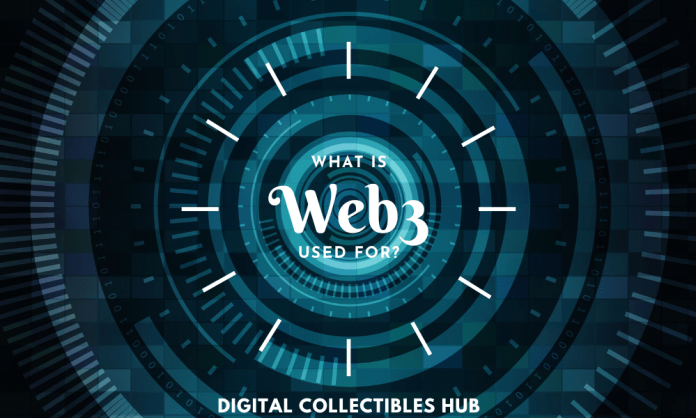Introduction
Web3, the latest evolution of the internet, is revolutionizing the digital landscape. It promises to bring decentralization, transparency, and user empowerment to the online world. But what exactly is Web3 used for, and how can it benefit you? In this article, we’ll explore the applications, examples, pros and cons, and answer frequently asked questions about Web3.
What Is Web3?
Web3, short for “Web 3.0,” represents the next phase of the internet. Unlike its predecessors, Web3 is built on blockchain technology, aiming to reshape the way we interact, transact, and collaborate online. It is decentralized, open, and user-centric.
Applications of Web3
1. Decentralized Finance (DeFi):
Web3 enables peer-to-peer financial transactions without the need for traditional intermediaries like banks. DeFi platforms like Ethereum-based decentralized exchanges (DEXs) and lending protocols are prime examples.
2. Non-Fungible Tokens (NFTs):
Web 3.0 has given rise to NFTs, unique digital assets representing ownership of items, art, music, and more. Artists and creators can monetize their digital works through NFT marketplaces.
3. Decentralized Applications (dApps):
Web 3.0 facilitates the creation of decentralized applications that run on blockchain networks. These dApps can range from social media platforms to gaming ecosystems, all with increased security and user control.
Examples of Web3 in Action
1. Ethereum: A blockchain platform that hosts a plethora of dApps, enabling developers to create and deploy smart contracts for various use cases.
2. Uniswap: A decentralized exchange (DEX) on Ethereum, allowing users to swap cryptocurrencies without a centralized intermediary.
3. Decentraland: A virtual world where users can purchase, build, and monetize on blockchain-backed virtual land parcels.
FAQs about Web3
Q1: Is Web3 the same as blockchain?
A1: No, Web3 is built on blockchain technology but extends beyond it. Web 3.0 encompasses various blockchain networks and protocols while focusing on user-centric, decentralized applications.
Q2: How can I get involved with Web 3.0?
A2: You can start by exploring and using Web 3.0 applications, participating in decentralized communities, or even developing your own dApps if you have coding skills.
Pros and Cons of Web3
Pros:
- Decentralization enhances security and reduces censorship.
- Increased user ownership of data and assets.
- Innovative opportunities for creators and developers.
- Empowers financially underserved populations.
Cons:
- Scalability challenges on some blockchain networks.
- Limited mainstream adoption and usability hurdles.
- Regulatory uncertainty in some regions.
- Risks associated with smart contract vulnerabilities.
Importance of Web3.0
The importance of Web 3.0 lies in its potential to revolutionize the internet and address some of the longstanding issues and limitations of the current web (Web 2.0). Here are several key reasons why Web3 is important:
-
Decentralization and Ownership
Web 3.0 is designed to be decentralized, meaning that it reduces the dominance of a few centralized entities (e.g., tech giants) and empowers individuals. Users gain more control over their data, digital assets, and online identities. This shift towards self-sovereignty is critical in an era of increasing concerns about data privacy and security.
-
Transparency and Trust
Blockchain technology, the foundation of Web 3.0, offers transparency through immutable, publicly accessible ledgers. This transparency can increase trust in online interactions, as users can verify transactions and data without relying on intermediaries. This is particularly important for sectors like finance, where trust is paramount.
-
Innovation and Interoperability
Web 3.0 fosters an environment where developers can create decentralized applications (dApps) on open protocols. This encourages innovation and allows for interoperability among different platforms. Developers can build on existing blockchain networks, creating a collaborative ecosystem.
-
Financial Inclusion
: DeFi (Decentralized Finance) is a major component of Web 3.0, and it has the potential to provide financial services to people who are currently underserved or excluded from the traditional financial system. This can lead to greater financial inclusion globally.
-
Ownership of Digital Assets
Web3 enables the creation and trading of non-fungible tokens (NFTs), which represent ownership of digital assets. This has opened up new possibilities for artists, musicians, and creators to monetize their digital work directly, without relying on middlemen.
-
Reducing Online Censorship
Decentralized platforms in Web3 can be more resistant to censorship since they don’t rely on centralized servers. This is crucial in regions where internet censorship is a significant issue.
-
Empowering Communities
Web3 encourages the formation of decentralized communities where decision-making is more democratic. Token-based governance systems allow users to have a say in the development of platforms and protocols they use.
-
Resilience and Security
The decentralized nature of Web3 can make the internet more resilient to cyberattacks and failures. Distributed networks are less vulnerable to single points of failure.
However, it’s important to note that Web3 is still in its early stages, and it faces challenges such as scalability issues, regulatory hurdles, and usability concerns. It’s essential to strike a balance between innovation and security, as well as address these challenges for Web3 to reach its full potential.
Conclusion
In summary, Web3 is the future of the internet, offering decentralized, user-centric, and transparent experiences. From DeFi to NFTs and dApps, its applications are diverse and growing. While it comes with its set of challenges, Web3 holds immense promise in reshaping how we connect, transact, and collaborate online. Embrace the possibilities of Web3 and stay prepared for the digital revolution ahead.
